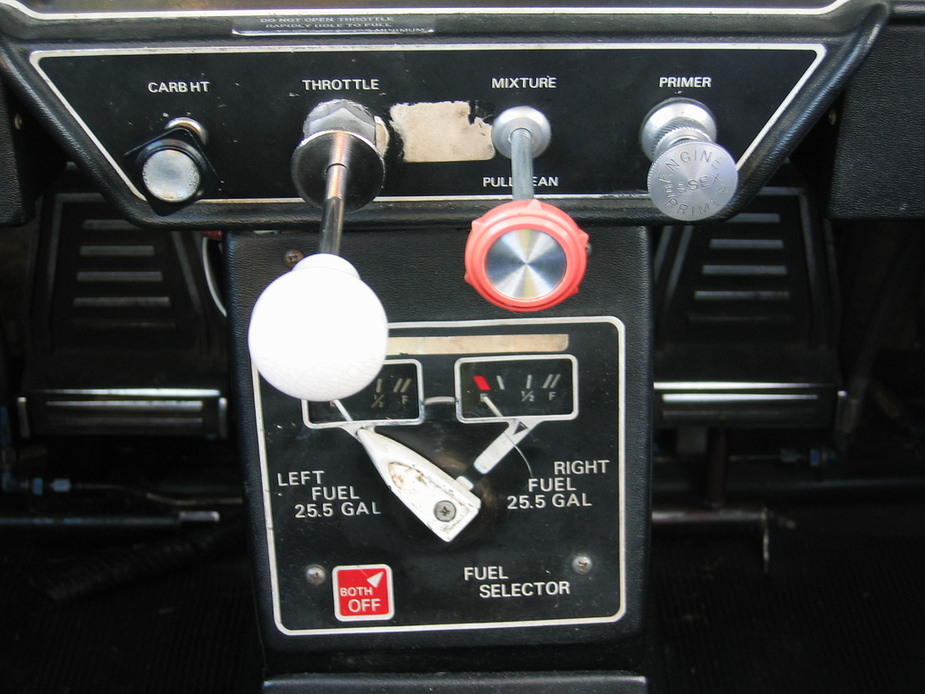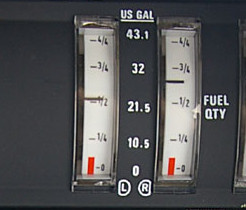To avoid venting high wing Cessnas (not 150/152 as it only has on or off), should be placed on right tank when parked.
Why the right tank in particular?
Some Cessnas only have one fuel tank vent, others have 2 or even 4.
I don’t think this recommendation makes much sense. There should be no negative effect from leaving the fuel selector on BOTH all the time. I usually leave it at BOTH during refueling as well because the connection line between the tanks is so small that you don’t lose much during the short time one wing is fuller than the other.
Most Cessna pilots do not know that the fuel tank equalization also happens when the fuel selector is in the OFF position. Only LEFT and RIGHT block that line.
The Bonanza is particularly awkward. In mine, the selector has three positions, left, right and off. It sits behind my left foot, literally down underneath the LHS side of the front seat. The fuel selector process appears to have caused a few incidents over the years in general Bonanza flight ops.
A change of tank mid flight results in me always looking down at what I am doing. It also has no perceptible detent, which can raise the level of excitement. I had a small spat with someone on another forum regarding switching the fuel to OFF after every flight. I leave mines on the tank that I used for landing, never actually switching it off. Given I am the only one that fly’s my aeroplane, this works for me..
I too never use the OFF position – except when the fuel filter is being removed at the Annual.
With fuel injection, with the mixture lever OFF, there is no open path for fuel. And the mixture should be OFF when parking anyway.
I like the fuel selector in the AA5 series. That is how it should be done. RIght in the center, big enough and pointing to the respective tank gauge.

That is quite a neat set up. Does exactly as it states on the tin…..I assume the gauges are wholly inaccurate, like all the others.
Looks good indeed. Still it is one single component that controls fuel flow from both tanks. Why not have two separate valves? That would avoid a “single point of failure”.
Very neat.
I second Beechbaby on the assumption on the gauges. While I can see some complexity in the “automatic” fuel selection, I find it a complete joke that the fuel gauges on a quite expensive plane, where fuel mismanagement has very serious consequences, are so notoriously inaccurate. My Audi will tell me exactly how many miles I have left before I need to walk, and that’s without any input or calculations from my side. It must be very simple to make an accurate gauge these days.
It is indeed possible to have reasonably good fuel gauges but the best you will ever get given the various issues (wing dihedral, etc) is perhaps a few % of FSD (full scale deflection).
That is what the TB20GT gauges are. They are probably accurate to the thickness of the needle

But that still isn’t any good for fuel planning during flight, versus winds etc. One needs a totaliser linked to the GPS. That gives you a continuously revised forecast of the LFOB (landing fuel on board)

The alternative is the traditional method which is to do manual calculations based on the time of arrival at various GPS waypoints. And once you have a totaliser, the fuel gauges are not used for anything much apart from maybe switching tanks during flight. When flying alone, I run my LH tank down about 5mm on the gauge, so the aircraft flies in balance.
Also, for most certified types, there isn’t an economically viable paperwork route to installing better gauges. But any aircraft can have a totaliser installed, for relatively very little money – usually under €2k.
That is quite a neat set up. Does exactly as it states on the tin…..I assume the gauges are wholly inaccurate, like all the others.
On the AA5 series aircraft I’ve got to fly, the gauges were actually reasonably accurate.